Cornering dark matter with the HAWC observatory and dwarfs
Dark matter is being searched for in many experiments, either directly by trying to detect its interactions with normal matter or indirectly by measuring the properties of the products of the annihilation of dark matter particles in the universe.
In this last case, one of the possible ways consists of investigating the properties of the spectrum of cosmic and gamma rays reaching Earth.
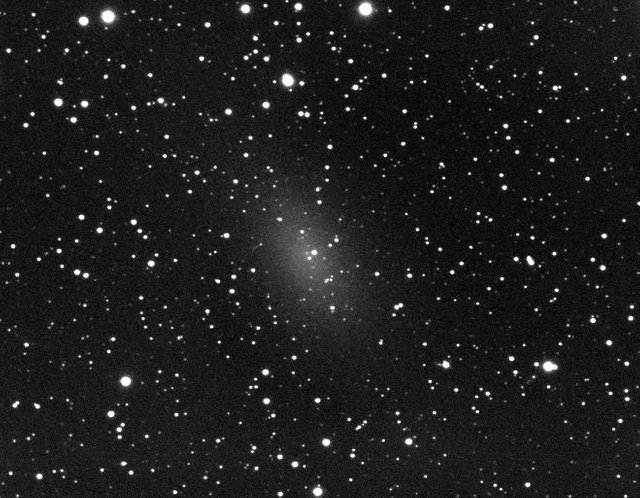
[image credits: Wikipedia]
After the exceptional last week in terms of physics results (i.e., the LIGO observation of a third gravitational wave), I am pleased to discuss today the recent results of the HAWC observatory that is sensitive to a wide range of gamma ray energies.
The HAWC collaboration has indeed released its first limits on the dark matter annihilation rate and decay lifetime, that can be found on this article that has been submitted to the Astrophysical Journal] and that appeared yesterday.
HAWC IN A NUTSHELL
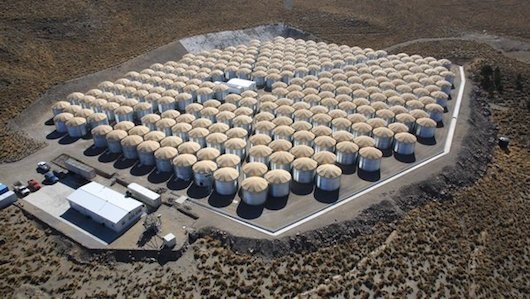
[image credits: HAWC]
The wording ‘HAWC observatory’ stands for an acronym. We can even say that is very usual: scientists like acronyms very much.
In this case, HAWC stands for the High Altitude Water Cherenkov observatory for which I show a picture on the left.
HAWC is located close to the Sierra Negra volcano in Mexico, at an altitude of 4100 meters above sea level. This is why it is called an high-altitude observatory, as can now be guessed. Being located in the northern hemisphere, HAWC is logically dedicated to the survey of the sky of the northern hemisphere of the planet.
HAWC tracks highly-energetic gamma rays whose energy is ranging from 500 GeV to a few hundreds of TeV. To put things into perspective, this corresponds to 1.000.000.000.000 times the energy associated with visible light. A visible photon indeed carries an energy of a couple of eV.
The way HAWC detects gamma rays relies on a grid of 22000 m2 of Cherenkov detectors. Those are the cylindrical cells that can be seen on the above picture.
Each of these detectors is a large tank of about 188.000 liters of water (after all, we have a W like water in HAWC) and contains a bunch of photomultipliers (cameras in rough words) that will record the Cherenkov light induced by a very energetic gamma ray entering into the atmosphere.
HOW TO DETECT GAMMA RAYS WITH CHERENKOV RADIATION
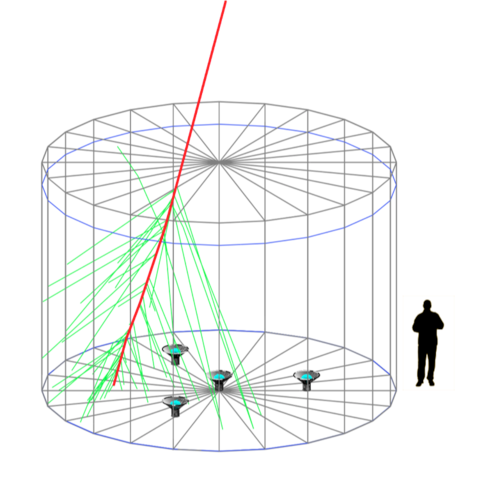
[image credits: Wikipedia]
One starts with the object we would like to detect: a very energetic gamma ray that enters the atmosphere of Earth.
When this guy enters the atmosphere, it can create an electron-positron pair, each of them being again very energetic (that is momentum conservation).
As a result, the electron and the positron moves at great speed towards the Earth, very close to the speed of light in the vacuum (300.000 km per second). However, before getting to the ground, these particles will induce the creation of other particles that will themselves induce other particles, and so on.
We end up with a cascade of very energetic particles that reach the surface of the planet, each of these particle having a significant spread. This is called an air shower.
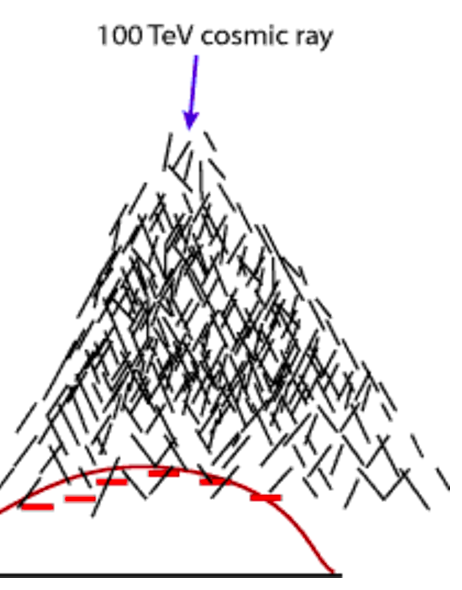
[image credits: HAWC]
These secondary particles will hit several of the HAWK detectors, as illustrated on the left.
The photomultipliers inside each water tank (the red bars in the picture) record the Cherenkov light that originates from the secondary particles traveling at a speed larger than the speed of light in water.
Whilst the speed of light in the vacuum is constant, it is not the case in a medium. The speed of light indeed depends of the type of material under consideration. In water, the speed of light is of about 225.000 km per second, i.e., 75% the value of the speed of light in the vacuum.
Therefore, it is possible that particles could travel at a speed larger than the speed of light in a given material. The only constraint is that the speed must be smaller than the speed of light in the vacuum (300.000 km per second).
When this phenomenon occurs, a charged particle emit what is called Cherenkov light. This is just the electromagnetic equivalent of the sonic boom for sound.
From this information, physicists can reconstruct what happened, the energy of the event, etc., and get information, e.g., on dark matter.
INDIRECT DARK MATTER DETECTION WITH DWARFS
Now we can go back to the title of the post!
There are multiple evidence reinforcing our expectations relatively to dark matter. But we have not directly observed any dark matter particle so far. Moreover, the true nature of a dark matter particle and what it is exactly is still unclear. That is why we have many experiments, like HAWC, trying to help on this aspect.
The idea of indirect dark matter detection is to probe regions of the universe where the density of dark matter is known to be large. In those dense dark-matter-populated regions, dark matter particles can annihilate into Standard Model particles (like photons, or in other words, gamma rays) that will then travel to Earth and be detected.
By investigating the features of the detected particles, we can extract information on the properties of the dark matter particles that have induced the process. For instance, the dark matter annihilation rate and decay lifetime are two of those properties (which have been investigated by the HAWC collaboration).

[image credits: Wikipedia]
One of the best candidates for searching for dark matter consists of astrophysical objects that are called dwarf spheroidal galaxies. Such an example is shown on the left (and at the beginning of this post by the way).
Those galaxies have the properties that their visible mass is much smaller than their total mass. I recall that the total mass of these galaxies is deduced by studying gravity around the considered galaxy, whilst the luminous mass is evaluated from the visible matter.
In short, dwarf galaxies contain much more dark than visible matter. They are thus perfect candidates for the study of dark matter.
THE RESULTS
HAWC has analyzed 15 dwarf galaxies from the local group, or 15 galaxies that are close to the Milky Way. These galaxies are very low luminosity galaxies and hence produce very few gamma ray from their visible content (in short, very low noise to a potential dark matter signal).
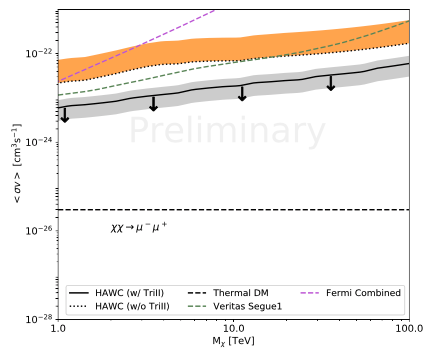
[image credits: HAWC article]
The results are provided as a limit on the dark matter annihilation rate, given as a function of the dark matter mass.
If the rate is large enough, we should have observed a signal. As no signal has been observed, that means that there is an upper limit on this rate. An example of results is shown on the left.
The black line (with the grey uncertainty band) is the HAWC limit. If we have a model with a given dark matter particle mass, the corresponding annihilation rate must be below the black line. The model is otherwise excluded.
We hence have HAWC results to which we can compare theoretical predictions to constrain and assess the viability of dark matter models.
TAKE-HOME MESSAGE AND REFERENCES
In this article, I described the HAWK observatory and discuss the new results that appear on the web this week. I have briefly depicted how the experiment works and presented the new results on the annihilation rate of two dark matter particles into gamma rays. These results been obtained from the observation of dwarf dark-matter enriched galaxies and the analysis of the resulting gamma ray spectrum.
I have also tried to sketch how this could offer new handles to constrain realistic dark matter models.
Absolutely wonderful article. I very much look forward to following your future articles. I love to learn. Thank you. I will be learning a lot from you.
It is my pleasure to share what I know :)
Did someone say "dark matter"? That is my favorite type of matter.
It is a very peculiar type of matter, indeed sensitive only to a specific type of dark force ^^
I don't know much about this but it was interesting to read.
It is my pleasure to share about it, as said above :)
Very interresting, thanks a lot for sharing !
My pleasure! There are plenty of laboratories close to your place, with people working on this :)
Yes i know:)
Cherenkov radiation is visible in the water pool of researh fission reactor. I've seen it from 3 meter height. Beautiful sight
Yes, this is right. This gives a bluish color to the water :)
Thank you my friend for this information
Congratulations @lemouth! You have completed some achievement on Steemit and have been rewarded with new badge(s) :
Click on any badge to view your own Board of Honnor on SteemitBoard.
For more information about SteemitBoard, click here
If you no longer want to receive notifications, reply to this comment with the word
STOPBy upvoting this notification, you can help all Steemit users. Learn how here!